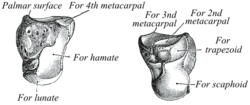Capitate
| Capitate bone | |
|---|---|

Left hand anterior view (palmar view). Capitate-bone shown in red.
|
|

The left capitate bone.
Left: ulnar surface (little-finger-side surface). Right: radial surface (thumb-side surface) |
|
| Details | |
| Identifiers | |
| Latin | Os capitatum; os magnum |
| MeSH | A02.835.232.087.319.150.150 |
| TA | A02.4.08.011 |
| FMA | 23727 |
|
Anatomical terms of bone
[]
|
|
The capitate bone /ˈkæpᵻteɪt/ is found in the center of the carpal bone region, colloquially known as the wrist, which is at the distal end of the radius and ulna bones. It articulates with the third metacarpal bone (the middle finger) and forms the third carpometacarpal joint. The capitate bone is the largest of the carpal bones in the human hand. It presents, above, a rounded portion or head, which is received into the concavity formed by the scaphoid and lunate bones; a constricted portion or neck; and below this, the body. The bone is also found in many other mammals, and is homologous with the "third distal carpal" of reptiles and amphibians.
The capitate is the largest carpal bone found within the hand. The capitate is found within the distal row of carpal bones. The capitate lies directly adjacent to the metacarpal of the ring finger on its distal surface, has the hamate on its ulnar surface and trapezoid on its radial surface, and abuts the lunate and scaphoid proximally.
The superior surface is round, smooth, and articulates with the lunate bone.
The inferior surface is divided by two ridges into three facets, for articulation with the second, third, and fourth metacarpal bones, that for the third being the largest.
The dorsal surface is broad and rough.
...
Wikipedia
